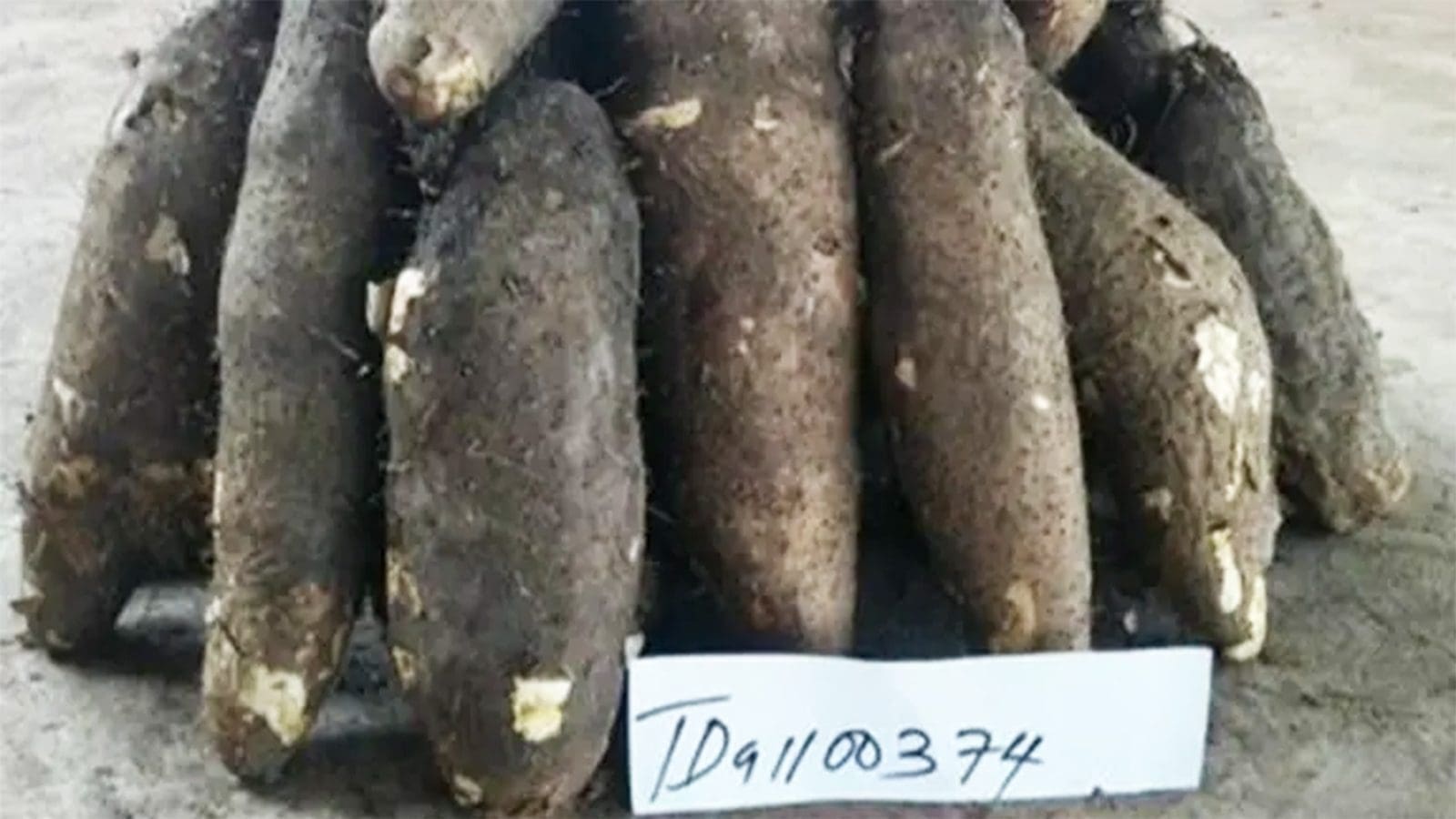AFRICA – The International Institute of Tropical Agriculture (IITA)-CGIAR in partnership with the National Root Crops Research Institute (NRCRI) has released three novel yam cultivars that are resistant to the yam mosaic virus and anthracnose, two of the most fatal yam diseases in Africa.
The three new cultivars, UMUDr35-Delight, UMUDr33-Blessing, and UMUDr34-Sunshine, also possess outstanding qualities, including high yield, high dry matter, and flour production, as well as favorable boiling and pounding properties.
D.alata (water yam) is the source of UMUDa35-Delight, whereas D. rotundata is the source of UMUDr33-Blessing and UMUDr34-Sunshine (white yam).
The UMUDa35-Delight water yam cultivar has a potential yield (t/ha) of 45.7 and a maturation period of 240–270 days.
UMUDr35-Delight contains cylindrical, hairy tubers with dark brown skin that is spiky in texture.
The cultivar contains amylose (38.10%), protein (5.74%), fat (0.31%), crude fiber (1.41%), sugar (5.25%), phytate (1.02%), and carbohydrate (CHO) (80.90%).
It has morphological features such as a green sagittate leaf, a robust and cylindrical tuber, a tuber with dark brown skin, and creamy white tuber flesh.
This nutrient-dense cultivar flourishes in the southern Guinea savanna, derived savanna, and humid rainforest. It has ash (3.3%), protein (7.3%), and crude fiber (2.0%).
The white yam cultivar UMUDr33-Blessing grows well in the southern Guinea savanna, derived savanna, and humid rainforest. It matures in 230–260 days and may produce 33 t/ha.
In addition to having a high yield and dry matter content, it also has minimal peel loss.
It has physical traits like a green cordate leaf, a cylindrical tuber, a dark green petiole, smooth light brown tuber skin, and creamy white tuber meat.
UMUDr33-Blessing contains the following nutrients: Amylose (34.41%), protein (4.77%), fat (0.33%), crude fiber (1.62%), sugar (5.13%), phytate (1.04%), and CHO (81.8%) are the other components.
The other white yam variety, UMUDr34-Sunshine, yields tubers with tiny, cylindrical corms and rough, brown skin.
The nutrient-rich type contains phytate (0.8%), amylose (34.4%), ash (3.3%), protein (7.3%), crude fiber (2.0%), and sugar (5.6%).
According to the findings, yam is a decently good supplier of minerals.
Some of the morphological features of UMUDr34-Sunshine include a green cordate leaf, a cylindrical tuber, a pale green petiole, a tuber with rough brown skin, and creamy white tuber flesh.
It thrives in the southern Guinea savanna and derived savanna, maturing in between 250 and 270 days with a potential yield of 31.8 t/ha.
Among its noteworthy advantages are its superb boiling and pounding abilities. Studies found that the various yam species have reasonable mineral supplies.
IITA is a renowned research-for-development (R4D) organization that offers solutions to Africa’s problems with hunger, poverty, and the depletion of natural resources.
Since 1967, IITA has collaborated with both international and domestic partners to strengthen food and nutrition security, create more jobs, protect the integrity of natural resources, and improve livelihoods.
The National Root Crops Research Institute (NRCRI) is an agricultural research institute in Nigeria that conducts research into the genetic improvement of economically important root and tuber crops.
Yam mosaic virus and anthracnose
The mosaic virus is a parasite that destroys plants, gardens, and crops down to their molecular level.
The virus is transmitted by aphids in a non-persistent manner, as well as through infected plant material from generation to generation.
Once a plant contracts the mosaic virus, the infected plant can then spread the virus to other plants and even affect an entire harvest if left untreated.
Infected plants usually show inter-veinal mosaic, curling, molting, and stunted growth, and the disease can result in significant yield losses in yam.
Anthracnose, caused by Colletotrichum alatae, is the most devastating fungal disease of yam in West Africa, leading to 50%–90% of tuber yield losses in severe cases.
In some instances, plants die without producing any tubers or each shoot may produce several small tubers before it dies if the disease strikes early.
For all the latest food safety news from Africa and the World, subscribe to our NEWSLETTER, follow us on Twitter and LinkedIn, like us on Facebook and subscribe to our YouTube channel.








